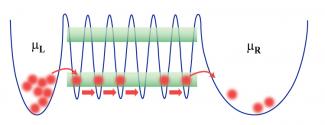JILA physicists are investigating complex and interesting materials, circuits, and devices based on ultracold atoms instead of electrons. Collectively known as atomtronics, they have important theoretical advantages over conventional electronics, including (1) superfluidity and superconductivity, (2) minimal thermal noise and instability, and (3) coherent flow. With such characteristics, atomtronics could play a key role in quantum computing, nanoscale amplifiers, and precision sensors.
A recent analysis by graduate student Brian Seaman, research associate Meret Krämer, and Fellows Dana Anderson and Murray Holland describes the operation of atomtronic batteries, circuits, diodes, and transistors. These devices are based on strongly interacting ultracold Bose atomic gases in lattices. The researchers show how the behavior of ultracold atoms in such systems is analogous to that of electrons in a doped semiconductor. Their study lays the theoretical groundwork for more advanced atomtronic devices, including amplifiers, oscillators, and logic gates.
Atomtronic devices use atom analogs of currents, batteries, and resistors. Atom flux, or current, plays the role of electric current. Atom currents appear when atoms can flow from a high-density region to a lower-density region. The difference in atom density creates a chemical potential, analogous to the electrical potential created inside a battery. If two optical lattices are connected by a waveguide, this "wire" will allow atoms to flow from a lattice with lots of atoms to another that contains just a few atoms. In this way, the optical lattices connected by a waveguide function as a "battery," as shown in the schematic at right.
In atomtronic circuits, increasing the height of an optical lattice will slow atom currents, as a resistor does in an electronic circuit. However, higher lattices don't dissipate heat and cause power loss as do resistors. In addition, precisely adjusting the height of adjacent optical lattices and changing the number of atoms in the lattices can create a "diode," which allows current flow in only one direction. Such atomtronic diodes are analogous to semiconductor diodes created by ajoining N-type and P-type semiconductors.
Similarly, atomtronic transistors can be created by aligning two diodes back to back to control a large current flow with a small current. However, in atomtronics, such an arrangement creates a large negative gain, which is the opposite of what happens in typical electronic transistors. This difference may require an adjustment in design to replicate electronic circuitry. Even so, the new theory of atomtronic transistors is particularly significant as it opens the door to the implementation of an atom amplifier in the near future.
Seaman and his colleagues' theoretical analysis of simple atomtronic devices and ciruits required finding solutions to multiple complex dynamics calculations. The researchers plan to build on this work by developing a more complex theory of atomtronics and developing more straightforward calculation methods. - Julie Phillips




